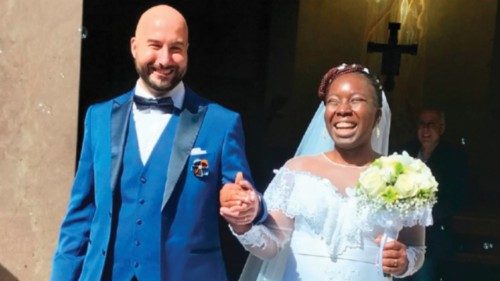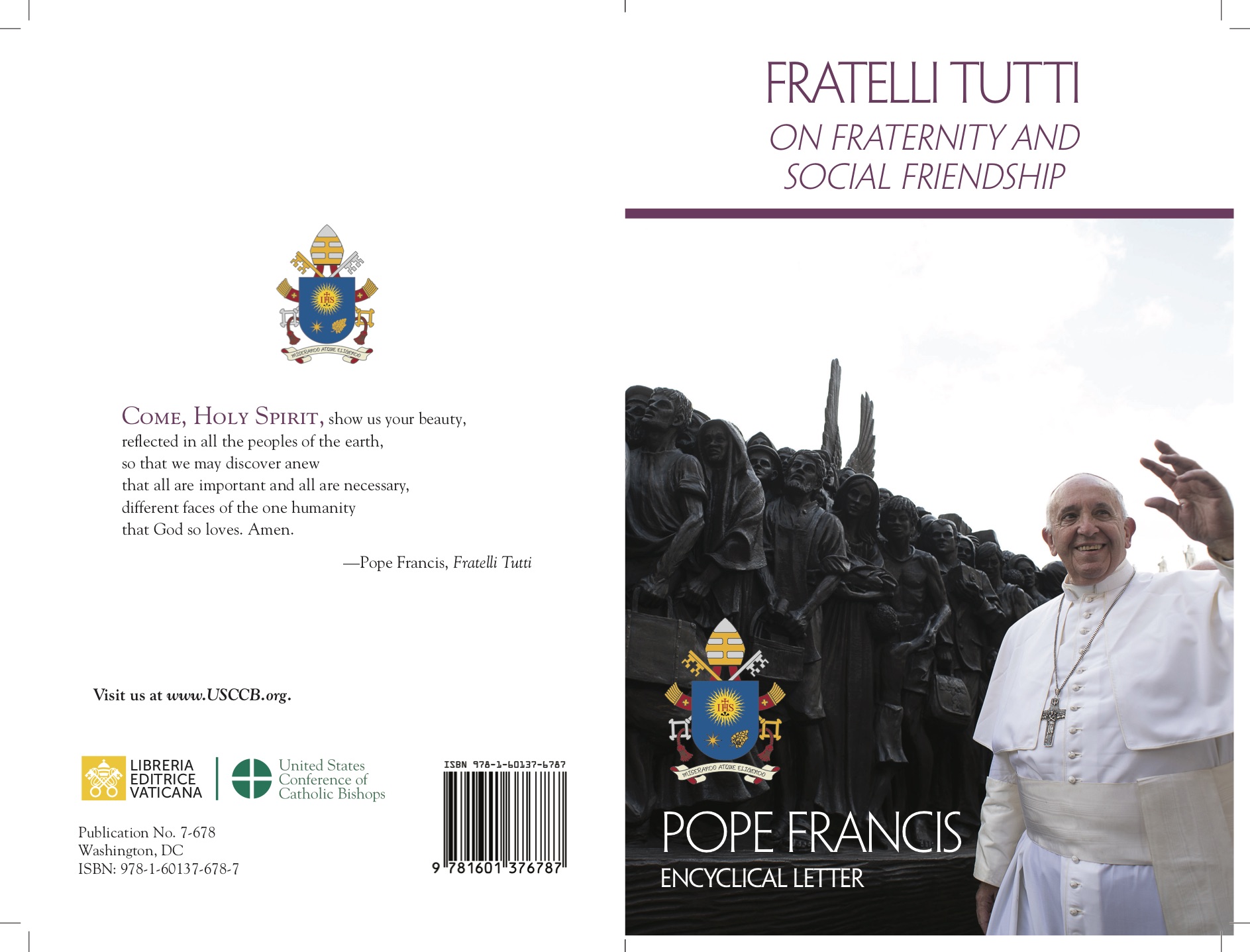
It all started with a smile. Or perhaps with a broken elevator. Joy and Andrea have nearly matching memories of when they realized their story would become a great one, while both are aware that it has been extraordinary from the very beginning.
We meet Joy and Andrea in a pleasant and welcoming apartment. It is a place full of life. The apartment, which is lent to them free of charge by the parish of San Gabriele dell’Addolorata in the Tuscolano-DonBosco district of Rome, where the Ursuline nun Rita Giaretta and her fellow sister Assunta Pavanello live in fellowship with young women, many of whom are survivors of trafficking. We are sitting at a table that has witnessed conversations, prayers, decisions, and moments of celebration. It is here, right here, that Andrea asked Sister Rita for Joy’s hand in marriage, because their love was clear to everyone. Sister Rita is Joy’s mother.
Joy Ezekiel, who was born in 1993 in Benin City, southern Nigeria, embarked on a journey that is terribly hard story to tell because the heart struggles to follow. At 23, she left for Italy with false promises. The desert was a torment, and Libya was a hell. 1,000 people in a basement, hunger, humiliation, every kind of violence, including a mass rape. Further ahead in the Mediterranean, there were 150 people on a rubber boat adrift in the open sea. “Who knows how to navigate?” No one. A mother raises her newborn child to the sky and prays, “Save us, God, do it for this child.” A ship is spotted, coming to rescue them. Forty-five people have died, the others survive.
Italy seemed like the promised paradise to Joy. However, it quickly turned into another form of captivity. The woman from Castel Volturno, a large municipality in the province of Caserta, Campania, who had financed her journey, now demanded her repayment through prostitution. However, before that, the Madam took the joy to a man who tore her unborn child from her womb: Joy had arrived in Italy four months pregnant. A few days later, she was on the streets with her first client. She had to pay off a “debt” of 35,000 euros to the Madam. For a year, she lived a life between despair and calculated hope. Joy prayed, “God, bring me clients.” Today, she says, “I should have prayed, ‘Set me free’”
One day, she made it. She ran, and someone helped her. The police officers took her to Sister Rita at Casa Rut, a place of healing in Caserta. “I asked God for forgiveness because I thought He had left me.” Rita, the nun with sparkling eyes and an open heart, became her mother. Joy started over in Caserta. She learned Italian, completed her high school diploma, and worked in a cooperative. Then came Rome. A diploma as an intercultural mediator. Conferences in schools and conventions. She told her story and the stories of many others. Giving voice to hope.
Then, not long ago, Andrea Francalanci came into her life.
Joy, who was attending a course to become a healthcare worker in Rome, often visited Sister Rita’s apartment on the sixth floor. Andrea, born in Arezzo, worked in a recording studio in the same building, on the ground floor.
One day, the elevator broke. Joy entered the studio, curious, she asked, “What do you really do here?” “The smile,” Andrea says today, “her smile left me breathless.”
He could not forget that smile. He asked the concierge, “Who is that girl?” “Do you mean Joy?” The concierge gave him the book (with a preface by Pope Francis) that tells Joy’s story. Andrea read it. The smile that had “sown something in my heart” took on an unexpected horizon.
They crossed paths again a few weeks later. The elevator - with its bright pink interior coverings - was working again, and Andrea accompanied Joy to the sixth floor. He felt “a little trapped.” They both laughed, so she decided to give him her number. “That way, you won’t have to ask the concierge anymore.”
Then a walk together in Villa Borghese. No beating around the bush. “What do you want from life?” Joy wanted a future, a family, joy, happiness. Andrea wanted the same. In previous relationships, “I was never sure how far I could go, everything was always a little suspended,” he says today. But with Joy, everything was clear.
They got married on October 5, 2024. A wedding for the whole parish, for the whole neighborhood, because love spreads, overflows, and contaminates. Rita was the wedding planner, the florist, the organizer, to the point that they had to send her away, saying “Now go to your daughter, you’re doing too much!”
Sister Rita then escorted the bride to the altar, as a natural father or mother would typically do. Her knees were shaking as she took this step, she recalls. “I never would have thought that in the course of my life, even in my religious path, this would happen; that God would give me this gift of accompanying a daughter in this way. It was as if He Himself was accompanying Joy, but He needed me to do it, to accompany her and also Andrea.”
Joy says of Andrea: “I love everything about him. His smile, his gestures, his calm voice. He is love to me.” Andrea says of Joy: “To me, she is what her name says, a great joy.” Initially, his family had some typical prejudices against his Nigerian fiancée. However, a girl with this strength and hope won them all over. “God believes in our project,” Andrea says today.
Sister Rita, however, was initially a little hesitant. She observes that her daughters often marry too quickly without coming to terms with their past. “The heart beats, it’s warm,” she explains, “but love also needs to be worked on. Love must become a gift.” This was the case with Joy and Andrea. “These two wanted to grow together, not just find a home. They wanted to discover God’s plan together”. That plan was to create a family, which is open to children, open to everything around them, and become a beacon of light for others.
Perhaps it was like this from the very beginning. A smile. A broken pink elevator. Two young people who found each other. A story that became greater than they could have imagined.
This is a love that lasts because it loves.
by Gudrun Sailer
Vatican News Journalist
Trafficking, 50 million victims
The UN Global Report on Human Trafficking 2024 reveals that the number of victims of human trafficking is around 50 million, marking a 25% increase in 2022 compared to the figures from 2019. The report also shows a 31% rise in the trafficking of minors over this three-year period.
Statistics highlight the disproportionate impact of human trafficking on women and girls, with 61% of victims being female and primarily exploited sexually. For boys, forced labor is the most common form of exploitation (45%), while 47% suffer from other forms of exploitation, including forced criminality, particularly online frauds and forced into begging.
Concerns about the trafficking of minors also extend to wealthier nations, where several cases of sexual exploitation have been reported.
July 30th is the International Day established by the United Nations in 2013 to raise awareness about this modern form of slavery and the need to protect the human rights of its victims.




 Purchase the Encyclical here Fratelli Tutti
Purchase the Encyclical here Fratelli Tutti